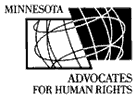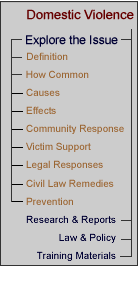|
|
|
SPECIALIZED DOMESTIC VIOLENCE COURT SYSTEMS Establishing specialized courts or court processes for domestic violence cases is another way to increase the judiciary’s responsiveness to domestic violence. Levels of specialization vary widely in those jurisdictions that have adopted this approach. Some jurisdictions have created courts that handle only domestic violence cases; others have altered court processes to ensure more effective processing of domestic violence matters; yet others have specialized staff that provide support to victims. Dedicating part of the court system to domestic violence issues sends a message to the community that violence will not be tolerated. Dedicated Courts and Prosecutors Some jurisdictions in the United States have created courts (often called dedicated courts) that handle all criminal and civil cases involving domestic violence. Other jurisdictions have created courts that handle all criminal domestic violence cases, or all misdemeanors. Other court systems have created dedicated teams of prosecutors that work only on domestic violence prosecutions. The importance of the role played by prosecutors, particularly in CEE/CIS, cannot be overstated. Dedicated courts and prosecution teams can have many advantages. Because all domestic violence cases are dealt with by the same group of judges or prosecutors, these individuals are able to gain expertise in the issues and to ensure more consistency in the treatment of these cases. They will be more sensitive to the needs of victims and be able to direct them to additional community resources. Dedicated courts or prosecution teams may also be able to process cases more quickly, thus reducing the opportunity a batterer has to intimidate his partner into abandoning the charges. Judges and prosecutors who consistently deal with domestic violence cases may see repeat offenders; having a more detailed background about the case may help them be more sensitive to the needs of the victim. Correspondingly, the fact that fewer individuals will deal with these cases can help deter future violence because offenders will expect increasing penalties and greater accountability. Offenders will know that if they batter again, they are likely to end up before the same judge or with the same prosecutor, where they will be less able to minimize or deny the violence. Others argue that judges who sit on specialized courts may be, or may appear to be, less impartial because of their expertise and knowledge about the history of a repeat offender. Opponents also argue that consistency can be a disadvantage; a consistently unresponsive court or prosecutor will be worse than a system that is only sporadically so. A specialized court may also require more security personnel because of the danger that abusers will use the opportunity provided by the court appearance to abuse, coerce, intimidate or harm their partners. Domestic violence cases are also difficult; those who work solely on these kinds of cases may experience burnout more quickly than others. Finally, dedicated courts and prosecution teams may run the risk of being marginalized. Singling out one court or team of prosecutors to handle domestic violence issues may generate an understanding of that entity as one that deals with “family” as opposed to “real” crimes, thus undermining efforts to gain recognition of domestic violence as a crime and relegating domestic violence to the realm of the family. From Julia Weber, Domestic Violence Courts: Components and Considerations, 2 Journal of the Center for Families, Children & The Courts 23, 29 (2000). Billie Lee Dunford-Jackson et al., Unified Family Courts: How Will They Serve Victims of Domestic Violence? 7. Similarly, opponents have voiced concern that the existence of one entity with domestic violence expertise will result in other judges and prosecutors feeling absolved of responsibility to be sensitive to domestic violence issues, even though not all domestic violence cases will be identified as such and may make their way in whole or in part through the general system. From Dag MacLeod & Julia F. Weber, Domestic Violence Courts: A Descriptive Study (2000). The usefulness of combining civil and criminal jurisdiction in one court has also been debated. Advocates of such an approach argue that combined courts allow victims to obtain all of the relief they need at once and in one place. Allowing victims to testify for the prosecution and obtain child support in one proceeding, for example, can greatly enhance the accessibility of the court; it can be difficult for women to get time off from work, to travel, or to find child care in order to make multiple appearances. Judges who hear both the civil and the criminal sides of a case develop extensive expertise about domestic violence issues and are better informed about the case. Finally, combining courts can ensure that civil and criminal orders do not conflict. There are, however, a number of arguments that counsel against combined courts. Depending on the legal system, there may be defendant’s rights issues connected with the use of information from one proceeding in another matter. Opponents also argue that judges or prosecutors in combined courts may bargain away criminal penalties in exchange for the defendant’s cooperation in civil proceedings (i.e., an agreement about custody or child support). Finally, opponents worry that victims will be required to cooperate with criminal prosecutions in order to gain civil relief, a requirement that raises the same autonomy concerns generated by mandatory prosecution. Adapted from Julia Weber, Domestic Violence Courts: Components and Considerations, 2 Journal of the Center for Families, Children & The Courts 23, 29 (2000). Billie Lee Dunford-Jackson et al., Unified Family Courts: How Will They Serve Victims of Domestic Violence? 7; Dag MacLeod & Julia F. Weber, Domestic Violence Courts: A Descriptive Study (2000). Dedicated Processing Some jurisdictions have altered the internal administrative processes of their courts in order to ensure that domestic violence cases are handled in a way that maximizes victim safety and batterer accountability. For example, many courts are scheduling and processing domestic violence matters (i.e., hearings on protective orders, pretrial conferences) separately from other matters. This ensures that cases are processed quickly, which can be critical. As time passes, the chance a victim will abandon the case increases; she may be in danger of losing her job because of the time she must to miss for court appearances, feel frustrated with the process or with having to repeat her story multiple times, or experience intimidation from her batterer. Other courts have changed the way they collect and track information about cases to better respond to the needs of victims and ensure that batterers are consistently being accountable. Many recent efforts use web-based technology to share information about offenders between different courts and between probation services and the courts. This technology makes it possible to identify domestic violence cases, cases involving the same defendant, or related cases (one couple may be involved in multiple proceedings concerning child custody, protective orders, and criminal charges). New York State, for example, has developed the Domestic Violence Court Technology Application and Resource Link, a software application that uses internet technology to connect domestic violence courts with law enforcement and social service providers. This program
Information sharing systems must, however, be paired with privacy and confidentiality protocols. These protocols should identify those who may access information, what information may be accessed, and the circumstances under which that can happen; this protocol can be translated into security measures that prevent unauthorized access. Dedicated Resources Other courts have a created specialized processes to ensure women seeking relief from violence are provided the support they need. Some courts have specialized support units (called intake units, case managers, or resource coordinators) that, among other things, may help women file for civil protection orders, provide women with referrals to community resources, screen for cases involving domestic violence, ensure that information about related cases is shared throughout the system, and coordinate scheduling of related matters. Other courts have witness assistants who accompany the victim to court and often are able to provide the court and the prosecutor with additional background about the case and the history of abuse that may not be evident from the record. The support unit can be part of or independent of the court. The District of Columbia’s support unit, for example, was created through cooperation between a public agency, a private enterprise, and a victim advocacy organization. It is critical that the victim is informed about the relationship between the court and support unit or witness assistant. If support staff are employees of the court, they may not be able to guarantee that the information she shares will remain confidential. Courts can adopt one or more of these features. New York State, for example, has chosen a combination approach that includes a dedicated court that hears all criminal domestic violence cases, a resource coordinator, an offender monitor (a staff person that follows defendants post-conviction to ensure they are complying with the terms of their sentence), and a victim advocate (similar to a witness assistant). Adapted from Randal B. Fritzler & Leonore M.J. Simon, Creating a Domestic Violence Court: Combat in the Trenches, Court Review 28 (2000); Lynn S. Levey, Martha Wade Steketee & Susan L. Keilitz, Lessons Learned in Implementing an Integrated Domestic Violence Court: The District of Columbia Experience 16 (2000); Julia Weber, Domestic Violence Courts: Components and Considerations, 2 Journal of the Center for Families, Children & The Courts 23, 29 (2000); Judge Amy Karan, Susan Keilitz & Sharon Denaro, Domestic Violence Courts: What Are They and How Should We Manage Them?, Juvenile & Family Court Journal 2 (1999); Billie Lee Dunford-Jackson et al., Unified Family Courts: How Will They Serve Victims of Domestic Violence?; Julie A. Helling, Specialized Criminal Domestic Violence Courts. |

